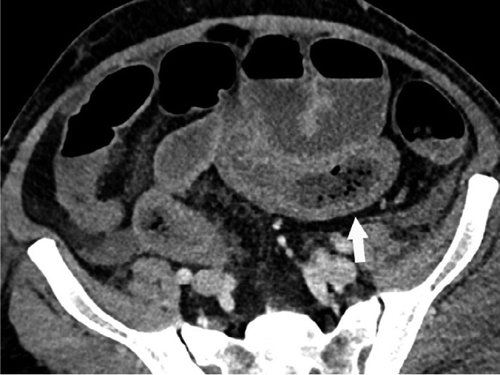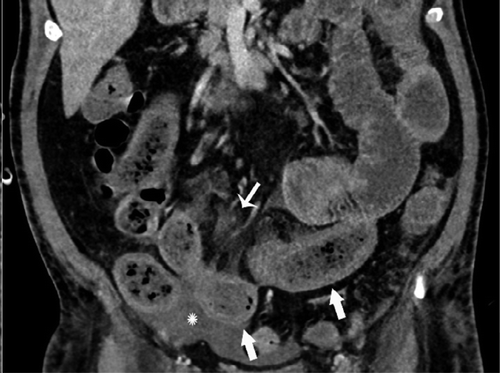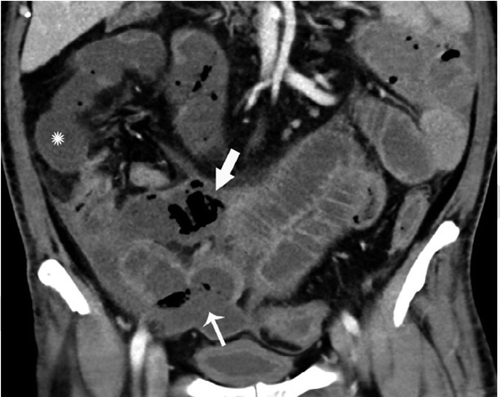Bowel Abnormalities Revealed with Abdominal Imaging in COVID-19 Patients
Affected patients were sicker and more likely to be admitted to the ICU.



Bowel abnormalities are more common among patients who are positive for COVID-19 than previously realized, new research has determined.
A new study, published May 11 in Radiology, determined that, while gastrointestinal symptoms, liver injury, and vascular findings are commonly reported in these patients, scant information has been available about abdominal imaging findings. These scans could improve provider understanding about abdominal manifestations in these patients, the authors said.
“Imaging findings may help understand abdominal phenomena in SARS-CoV-2 infection,” said the investigators, led by Rajesh Bhayana, M.D., abdominal imaging fellow in the radiology department at Massachusetts General Hospital (MGH). “Further, radiologists should be aware of abdominal imaging findings in patients with COVID-19.”
To determine the abdominal impacts, the team conducted a retrospective study with 412 patients, all over age 18, who tested positive for COVID-19 and were admitted into MGH from March 27 to April 10. The group included 241 men (58.5 percent) and 171 women (41.5 percent), and the average age was 57. From this population, 136 (33 percent) were admitted to the intensive care unit (ICU).
A total of 224 abdominal imaging scans were performed on 134 patients, and of that group, 72 patients (17 percent) had cross-sectional abdominal imaging – 44 ultrasounds, 42 CT scans, and 1 MRI. Bowel abnormalities, including thickening and ischemia, such as pneumatosis and portal venous gas, appeared in 31 percent of CT scans, occurring most frequently in ICU patients. Surgical correlation in four patients revealed unusual yellow discoloration of bowel in three of the four, as well as dead bowel in two patients.
“We found bowel abnormalities on imaging in patients with COVID-19, more commonly in sicker patients who went to the ICU,” Bhayana said.
In addition, two patients had bowel resection, and pathology reports showed ischemia with patchy necrosis. Both individuals had blood clots in the small arteries of the bowel wall. This finding indicates that the small blood clots may have been responsible for the bowel ischemia, they said.
Other outcomes included a COVID-19 diagnosis based on lung base findings in a patient who presented only with abdominal symptoms, dilated sludge-filled gallbladder that suggested cholestasis, and decreased bile flow.
“Some findings were typical of bowel ischemia, or dying bowel, and in those who had surgery we saw small vessel clots beside areas of dead bowel,” Bhayana explained. “Patients in the ICU can have bowel ischemia for other reasons, but we know COVID-19 can lead to clotting and small vessel injury, so bowel might also be affected by this.”
These bowel findings in COVID-19-positive patients could have been caused by a variety of mechanisms, including direct viral infection, small vessel thrombosis, or non-occlusive mesenteric ischemia. The virus that causes COVID-19 is thought to infiltrate cells via the surface expression of angiotensin converting enzyme 2 (ACE2), making cells with high ACE2 levels particularly vulnerable to direct infection.
“ACE2 expression is most abundant in lung alveolar epithelial cells, enterocytes of the small intestine, and vascular endothelium suggesting that small bowel and vasculature may be susceptible to SARS-CoV-2 infection,” they wrote.
Overall, they said, their study is preliminary and additional research is needed to further clarify what causes bowel findings in COVID-19-positive patients and to pinpoint whether the virus plays a direct role in bowel or vascular injury.
GE HealthCare Debuts AI-Powered Cardiac CT Device at ACC Conference
April 1st 2025Featuring enhanced low-dose image quality with motion-free images, the Revolution Vibe CT system reportedly facilitates improved diagnostic clarity for patients with conditions ranging from in-stent restenosis to atrial fibrillation.
New AI-Enabled Portable Ultrasound May Facilitate 50 Percent Reduction in Cardiac Imaging Scan Time
March 28th 2025Artificial intelligence (AI)-powered measurement capabilities provide key features with the Compact Ultrasound 5500CV device, which was unveiled at the American College of Cardiology (ACC) conference.
The Reading Room: Racial and Ethnic Minorities, Cancer Screenings, and COVID-19
November 3rd 2020In this podcast episode, Dr. Shalom Kalnicki, from Montefiore and Albert Einstein College of Medicine, discusses the disparities minority patients face with cancer screenings and what can be done to increase access during the pandemic.
Predicting Diabetes on CT Scans: What New Research Reveals with Pancreatic Imaging Biomarkers
March 25th 2025Attenuation-based biomarkers on computed tomography (CT) scans demonstrated a 93 percent interclass correlation coefficient (ICC) agreement across three pancreatic segmentation algorithms for predicting diabetes, according to a study involving over 9,700 patients.